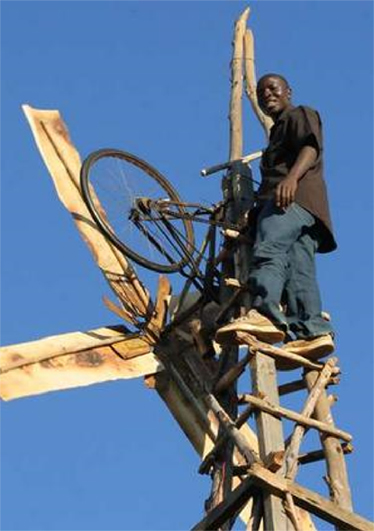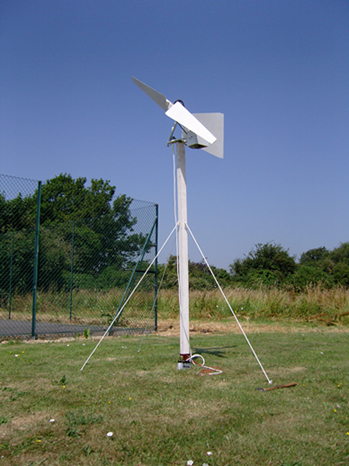A boy who had to leave school at 14 shows the world how to harness wind energy by using dumped objects. Sam Burcher
William Kamkwamba was only 14 years old when he built a windmill to provide his family home in a remote village in Malawi with enough electricity to read by and to listen to the radio [1]. William first started thinking about energy when he had to drop out of school early because his parents could no longer afford the school fees after their maize harvest failed in 2001. He got his idea from a school library book called “Using Energy” and modified a design for a windmill with materials that were to hand such as an old bicycle, broken PVC pipes, a pair of worn out shoes, copper wire and a tractor fan.

William and his wind turbine from scrap
William's motivation for his invention was the health of his sisters. At night their home would be lit with paraffin candles that emit toxic fumes similar to those of burning diesel, which was making his sisters ill from the smoke. At first his neighbours mocked him saying that he was going mad, but William persevered with the design because the book told him that it worked.
In Malawi only 2 percent of the population enjoy household electricity, so Williams' neighbours, who had no electricity at all, soon changed their minds when they heard the sound of Malawian music coming from his house. They were even happier when they realised that William's windmill could re-charge their mobile phones too.
His first attempt at a windmill gave his family enough energy to light one room so William decided to adapt the design further by adding a fourth rotor blade to create more power. He asked a local tinsmith to cut more efficient steel blades from a recycled oil drum and added a second windmill below the original blades that had been fashioned from heated, flattened and shaped PVC pipes . He also replaced the bicycle chain that doubled as a pulley rotor with an old car fan belt that worked much better.
The new design speeded up the dynamo (electric generator), the sort that powers bicycle headlights, from generating 12 volts of electricity to 20 volts of electricity. This was enough to provide energy to the battery for lighting his whole house, plus two radios, two mobile phone chargers and a car battery for backup power. The windmill is atop a 12 metre tall tower made out of blue gum tree poles that can catch the wind high above the windy village of around sixty families. William has also experimented with a radio transmitter that can serve his local community. He plans to broadcast important HIV prevention messages as well as popular music to a 20 square mile radius [2].
William's project encountered several problems along the way. He had to improvise necessary electrical components such as light switches from the rubber off old shoes and some springs. He also needed a generator, which a friend gave him. With the help of other farmers, he found discarded scrap materials on the tobacco plantations in his locality.
Since building his windmill William has been made a Fellow of TEDGlobal, a not for profit conference that brings together exceptional people from around the world who specialise in Technology, Entertainment and Design (TED). In his conference speech in Tanzania in 2007, William said, “When I dropped out of school, I went to the library and read and gathered information about how to make a windmill. And I tried, and I made it.” [3].
William was flown over New York in a helicopter; visited wind farms in the USA, exhibited at the Museum of Science and Technology in Chicago; wrote a book about his windmill [4]; was the subject of an award-winning short documentary film [5]; and set up a blog about how he harnessed the wind to produce a reliable source of electricity for his community [6].
Supporters in his native country are impressed with the actions of a boy who did not blame his parents, the power companies, the government, or policy makers for his lack of education. William simply got on with the task in hand. His efforts have resulted in his addressing the World Economic Forum Africa in 2008, where he dined with the President of Malawi. At the 2009 TEDGlobal conference in Oxford , the young inventor, now 21 years old, gave a lecture about his experiences so far.
William's story has attracted interest around the world and through TED he has been given financial help to improve his project by incorporating solar energy. This expanded system has allowed him to add a deep-water well that pumps water to irrigate crops in his native Mastala village in Kusungu district. His next project is to re-design a new classroom for his local school, which has no lighting or water.
Through the interest garnered by a Malawi's Daily Times article entitled, "School Drop-Out with a Streak of Genius " and the University of Cape Town as well as TED, William was sponsored to return to secondary school after five years' break and has completed his studies as an electrical engineer at the African Leadership Academy in Johannesburg. His next step is to start a windmill company and to teach.
This success story may also have acted as catalyst for a more recent project at Portsmouth University [7]. Max Robson, a 22 year old graduate has created a wind turbine from recycled materials found at the roadside and in front gardens. The “Envirocycle Scrap Wind Turbine” prototype converts kinetic energy from the wind into 73 watts of electricity which trickles down and can then be stored in a battery. When fully charged the battery provides energy for 63 hours of lighting and 30 hours of radio [8]. Max's next windmill aims at producing ten times that amount of energy.
The Envirocycle project was privately funded so that scrap turbines can be used to help people in the poorest parts of the world. Meanwhile, Portsmouth University is supporting Max's research through a postgraduate Masters Degree to develop the project using the University's resources. So far two primary schools in the UK have invested in the educational pack that Max has produced so that schools can build their own turbines and learn about renewable energy. One school is running a laptop off their turbine and the ultimate aim of the research is to link with the schools in the developing world that are also producing energy from wind turbines.

Max' Envirocycle Scrap Wind Turbine
Max Robson's prototype windmill cost £20 to produce from reclaimed scrap and is 1.8 metres wide, so it is low cost and low impact on the surrounding environment. The finished product, which has been painted with hard wearing white paint (pictured) costs around £60, which is remarkable because, as Max points out, the nearest alternative wind turbine on the market costs £2 000. The Envirocycle can be constructed using hand tools in a matter of days.
An example of small-scale wind turbines called “Micro Wind Turbines” that have been used for decades on boats have been adapted for household use and are springing up on UK urban rooftops. These mini turbines supplement national grid electricity and cost around £1 000 after grants, or £1 500 fully installed from a high street DIY store, which can save the homeowner around 30 percent on electricity bills per year. Another, even cheaper micro-wind turbine can be used to charge batteries with electricity. These cost around £800, but also require the cost of a power inverter to convert 12 or 24 DC volts (V) into 240 AC V as well as a bank of suitable batteries [9]. This is the wind turbine that the Conservative leader David Cameron has on his roof.
Max and William have demonstrated that ingenious, alternative and affordable local solutions to small-scale electricity needs can by made by using relatively easily found scrap for a global renewable future.
Article first published 05/08/09
Comments are now closed for this article
There are 4 comments on this article.
Todd Millions Comment left 1st September 2009 14:02:24
Sounds like he's doing fine without the tech school-Never confuse education with mere skoolin or you'll end up electing war criminals(un indited) for catholic primeministers-and wouldn't that indicate headuparseitus!Which in canada we refer to as 'hogge towne syndrom'(caused by severe inbreeding apparently).
William may wish to learn that scrapped blower motors from old car heater systems can be used for 12volt generators of 10-20amp capacity.The permenant magnet ones are easiest to use in this.He should also have the vertical wind turbines designed by Lenz(windstuffnow.com)brought to his attention.
On his trip to america-did it occur to any one to supply him with LED bulbs for his home lighting system?
Mr.Dada Yisau Comment left 6th August 2009 14:02:39
I,m so impressed by the action of this lad and will like to suggest that the Government should give him all necessary assisstance(s).Let him commence his school & after secondary he should proceed to TECHNICAL COLLEGE where he will be able to develop more.
Jenn Comment left 7th August 2009 00:12:26
Goes to show we can all have our own electric company. The electricity is all around us, all we need to do is generate it. A few solar panels, a couple windmills, and we're off the grid.
andrew williams Comment left 24th August 2011 05:05:08
this is also worth a try
http://www.youtube.com/watch?v=nziChzZWksE